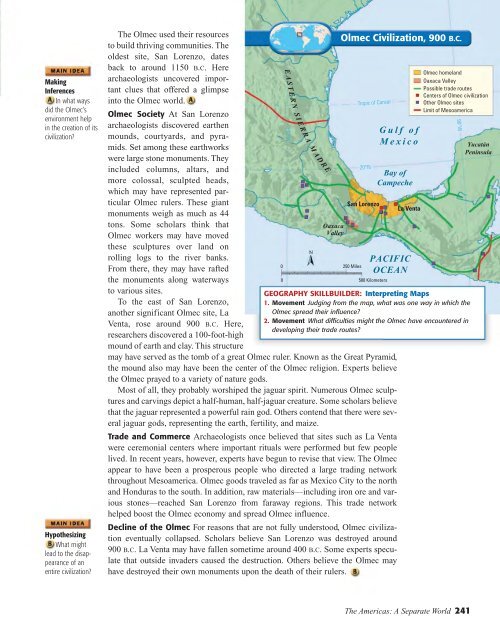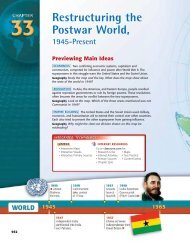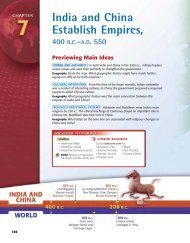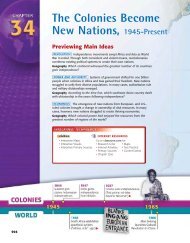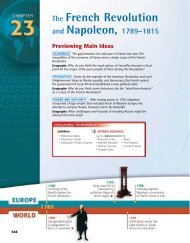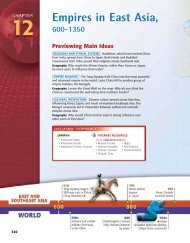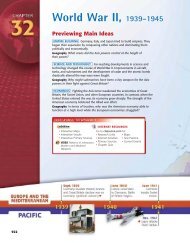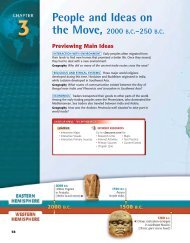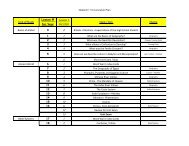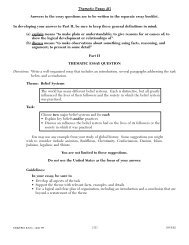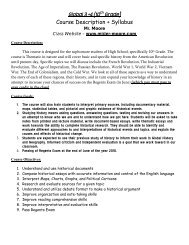The Americas: A Separate World, - First
The Americas: A Separate World, - First
The Americas: A Separate World, - First
You also want an ePaper? Increase the reach of your titles
YUMPU automatically turns print PDFs into web optimized ePapers that Google loves.
Making<br />
Inferences<br />
In what ways<br />
did the Olmec’s<br />
environment help<br />
in the creation of its<br />
civilization?<br />
Hypothesizing<br />
What might<br />
lead to the disappearance<br />
of an<br />
entire civilization?<br />
<strong>The</strong> Olmec used their resources<br />
to build thriving communities. <strong>The</strong><br />
oldest site, San Lorenzo, dates<br />
back to around 1150 B.C. Here<br />
archaeologists uncovered important<br />
clues that offered a glimpse<br />
into the Olmec world.<br />
Olmec Society At San Lorenzo<br />
archaeologists discovered earthen<br />
mounds, courtyards, and pyramids.<br />
Set among these earthworks<br />
were large stone monuments. <strong>The</strong>y<br />
included columns, altars, and<br />
more colossal, sculpted heads,<br />
which may have represented particular<br />
Olmec rulers. <strong>The</strong>se giant<br />
monuments weigh as much as 44<br />
tons. Some scholars think that<br />
Olmec workers may have moved<br />
these sculptures over land on<br />
rolling logs to the river banks.<br />
From there, they may have rafted<br />
the monuments along waterways<br />
to various sites.<br />
To the east of San Lorenzo,<br />
another significant Olmec site, La<br />
Venta, rose around 900 B.C. Here,<br />
researchers discovered a 100-foot-high<br />
mound of earth and clay. This structure<br />
E A S T E R N S I E R R A M A D R E<br />
may have served as the tomb of a great Olmec ruler. Known as the Great Pyramid,<br />
the mound also may have been the center of the Olmec religion. Experts believe<br />
the Olmec prayed to a variety of nature gods.<br />
Most of all, they probably worshiped the jaguar spirit. Numerous Olmec sculptures<br />
and carvings depict a half-human, half-jaguar creature. Some scholars believe<br />
that the jaguar represented a powerful rain god. Others contend that there were several<br />
jaguar gods, representing the earth, fertility, and maize.<br />
Trade and Commerce Archaeologists once believed that sites such as La Venta<br />
were ceremonial centers where important rituals were performed but few people<br />
lived. In recent years, however, experts have begun to revise that view. <strong>The</strong> Olmec<br />
appear to have been a prosperous people who directed a large trading network<br />
throughout Mesoamerica. Olmec goods traveled as far as Mexico City to the north<br />
and Honduras to the south. In addition, raw materials—including iron ore and various<br />
stones—reached San Lorenzo from faraway regions. This trade network<br />
helped boost the Olmec economy and spread Olmec influence.<br />
Decline of the Olmec For reasons that are not fully understood, Olmec civilization<br />
eventually collapsed. Scholars believe San Lorenzo was destroyed around<br />
900 B.C. La Venta may have fallen sometime around 400 B.C. Some experts speculate<br />
that outside invaders caused the destruction. Others believe the Olmec may<br />
have destroyed their own monuments upon the death of their rulers.<br />
100°W<br />
Oaxaca<br />
Valley<br />
0 250 Miles<br />
Tropic of Cancer<br />
20°N<br />
San Lorenzo<br />
0 500 Kilometers<br />
Olmec Civilization, 900 B.C.<br />
Gulf of<br />
Mexico<br />
Bay of<br />
Campeche<br />
La Venta<br />
PACIFIC<br />
OCEAN<br />
Olmec homeland<br />
Oaxaca Valley<br />
Possible trade routes<br />
Centers of Olmec civilization<br />
Other Olmec sites<br />
Limit of Mesoamerica<br />
GEOGRAPHY SKILLBUILDER: Interpreting Maps<br />
1. Movement Judging from the map, what was one way in which the<br />
Olmec spread their influence?<br />
2. Movement What difficulties might the Olmec have encountered in<br />
developing their trade routes?<br />
<strong>The</strong> <strong>Americas</strong>: A <strong>Separate</strong> <strong>World</strong> 241<br />
90°W<br />
Yucatán<br />
Peninsula


